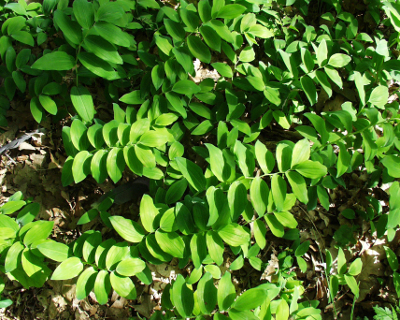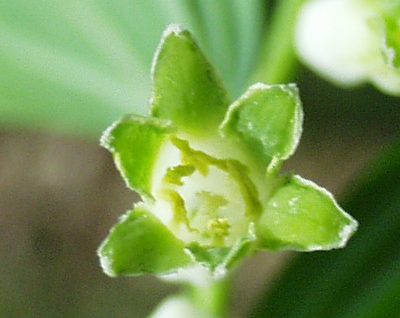Polygonatum, Solomon's-seals |

Habit of the Solomon's-seal

The
inflorescences of the King Solomon's-seals
grow from the
leaf axils

A flower inside
While Linnaeus listed in 1753 Solomon's seals still under the lilies of the valley (Convallaria), Philip Miller established one year later in the 4th edition of his work Gardeners Dictionary and its abridgement the genus Polygonatum.
The exclusively in the northern temperate zone occurring Solomon's-seals are perennial herbs with a long, nodular, creeping and generally branched rootstock. The stem is erect or bent and unbranched. The simple, entire, shortly stalked or sessile leaves are arranged alternate, more rarely whirl-like or opposite. The leaf blades are elliptical to linear.
The hermaphrodite flowers are arranged in axillary 2- to 15-flowered, usually pendulous panicles or racemes or they are solitary. The 6 petals are fused to about half to form a cylindrical tube. The 6 stamens are inserted in the corolla tube and do not protrude from the flower. The superior ovary is composed of 3 carpels and bearing a slim stylus with capitate or indistinct 3-lobed scar.
After self or insect pollination (bumblebees, bees, butterflies) round, black, dark blue or red, glaucous, soft, sweet and poisonous berries are formed with 6–24 spherical seeds.
| Floral formula: |
| * [P6 A6] G(3) superior |
Historical publications
Dioscorides (1st century AD.) wrote that Polygonaton was a shrub with laurel-like leaves. In the leaf axils were white flowers that would exceed the number of leaves, one would start counting from the root. The white, nodular, thick root would remove spots on the face and could heal wounds.
Leonhart Fuchs (1501–1566) differed a wide and a narrow Solomon's-seal (Polygonatum multiflorum and P. verticillatum). The former possessed laurel-like leaves and was astringent as the quince. Between the leaves were growing white to greenish flowers that resembled long bells. After flowering therefrom were formed round grains, first green, then black. The root was white, long and nodular. The latter species possesses narrower leaves, greener flowers and a smaller root.
Meaning of the species name
- multiflorus: lat. multiflorus = multiflowered
Interesting notes
Some species can be easily interbreed. At plant sellers there are therefore numerous Solomon's-seal hybrids and varieties, some with variegated leaves.
The angular Solomon's seal (Polygonatum odoratum), which does not occur in the Emsland region, can be distinguished above all by the number of flowers per axil (1–2) from the Solomon's seal (Polygonatum multiflorum) (2–5).
Not all Polygonatum species are poisonous. In China and in North America species occur, which rhizome is edible.